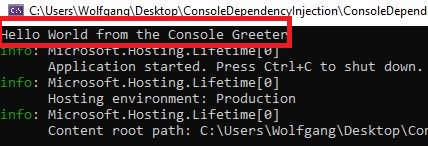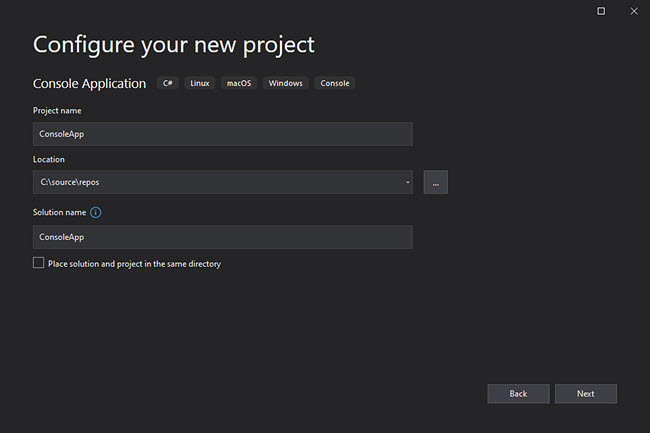Zaitsman sure in this example totally not required. Public class MessageWriter public void Writestring message.

Dependency Injection In A Net Core Console App By Zach Saw Medium
Currently there arent any additional parameters for this function as configuration is read from environment variables and a dtconfigjson file.

. From NET CLI run following commands to add Packages. Using either the dotnet new command or an IDE new project wizard create a new NET console application named ConsoleDIExampleAdd the MicrosoftExtensionsHosting NuGet package to the project. The telemetry data includes traces metrics and logs.
Create a new console application. After reading many - many. To add configuration in a new NET console application add a package reference to MicrosoftExtensionsHostingModify the Programcs file to match the following code.
Stritof you do understand this is in the console app and once DoWork exits the whole app exits including the entire dotnet runtime. Dependency injection in NET is a built-in part of the framework along with configuration logging and the options pattern. - outdated blogs I decided to add my 50 cents.
Avoid creating global state by designing apps to use singleton services instead. Dotnet add package MicrosoftExtensionsDependencyInjection. In this post I explain how to get logs.
PrerequisitesNET Core 31 SDK or later. For example the following installs the dotnet-trace global tool and starts a simple ASPNET Core NET 6 app collecting the DI events. It requires using DynatraceOpenTelemetry.
A dependency is an object that another object depends on. Dependency injection in a console app. In this article we will be building a Net 5 console app which support dependency injection logging and app settings configuration.
Two things need to be done. Now that all the refactoring is done. Direct instantiation couples the code to a particular.
Open up your Programcs file and add the following. Observe that wed added the using statement of DependencyInjection again here because the GetRequiredService method on the ServiceProvider is an extension from the MicrosoftExtensionsDependencyInjection namespace so wed definitely need that using statement to access this method. Install nuget MicrosoftExtensionsDependencyInjection.
You just need to follow the below steps for better organized DI implementation in Command-Line applications. Just the root command to show the help text and see the configuration is working as expected lesson student. It has integration of IoCNinject.
Firstly I will install the Dependency Injection NuGet package MicrosoftExtensionsDependencyInjection. However NET provides a way to get the data from outside the application using ETW or the diagnostics event pipe. When using OpenTelemetry the application publishes the data to the OpenTelemetry Collector or exposes endpoints to get the data.
Secondly once the package is added I will create a class ContainerConfiguration to register for all the classes. I got tired of figuring this out everytime I had a play with something in a console application. Aug 9 2021 at 042.
When designing services for dependency injection. MicrosoftExtensionsDependencyInjectionIServiceCollection Action - MicrosoftExtensionsDependencyInjectionIServiceCollection Public Function AddLogging services As IServiceCollection configure As ActionOf ILoggingBuilder As. New NET console applications created using dotnet new or Visual Studio by default do not expose configuration capabilities.
Build and Run Commands. Its only logical to want the same feature in your Console app. Dotnet new console -o ConsoleApp3.
Configure console apps. Add the following NuGet package before writing any logic here. Its a class library that communicates to console application by the interface.
Avoid direct instantiation of dependent classes within services. Also configuration needs to be setup but it is pretty easy. Its a class library which has an edmx file where the database table is mapped.
DI is a great pattern to understand and use even when just having a play. Here we create a new ServiceCollection object and configure it inside of ConfigureServices. Therefore it is time to add Net Core DI framework to the code.
AddDynatrace is an extension method to OpenTelemetrys TracerProvider. For details see Integrate OpenTelemetry on Azure Functions consumption plan. We are going to build a sample application which will mimic connecting to a database through dependency injection as well as outputting logs.
There is not much complicated coding involved in order to include the Dependency Injection feature in the NET Core Console applications. Now add logging to the service collection private static void ConfigureServicesIServiceCollection services. First include Microsofts ServiceProvider in your app see this post.
Dotnet tool install-g dotnet-trace dotnet trace collect --providers Microsoft-Extensions-DependencyInjectionVerbose -- name aspnettestexe The resulting trace can be viewed in PerfView on Windows. MicrosoftExtensionsLogging MicrosoftExtensionsLoggingConsole Your project should look like this. Once application is created Add the MicrosoftExtensionsDependencyInjection and MicrosoftExtensionsLogging Nuget Packages into the Project as shown below.
In ConfigureServices we add our dependencies to the container collection of which can have a lifetime of Scoped Transient or Singleton. Our console app starts out in Main. Examine the following MessageWriter class with a Write method that other classes depend on.
In addition to the service provider Nuget packages add these 2 Nuget packages. But generally if service provider is. Design services for dependency injection.
Please take a look below. Static member AddLogging. When you are used to building web applications you kind of get hooked to the ease of Dependency Injection DI and the way settings can be specified in a JSON file and accessed through DI IOptions.
Lets build the project and run some commands and see what they display. Familiarity with creating new NET applications and installing NuGet packages. With these changes in place we can now compile our command-line app and use the MicrosoftExtensionsDependencyInjection engine.
我也想使用 DI 工具包所以我选择了应该与这个平台兼容的MicrosoftExtensionsDependencyInjection 顺便说一句我无法理解如何将依赖项注入到我的 ViewModel 中 我把这个帖子红了 How can I use MicrosoftExtensionsDependencyInjection in an NET Core console app. Examples based on Jonathan Williams - Dependency Injection In a C Console Application NET Core Required nuget packages are MicrosoftExtensionsHosting. Its a class library that performs insert operation for the entity.
Avoid stateful static classes and members. So it seems that is pretty easy to add Ms dependency injection in a console app. Once the application has been create open the application.
A console application which runs.

Configure Dependency Injection For Net 5 Console Applications Programming With Wolfgang

Azure Logging In Application Insights For Net Core 2 1 Console App With Loggerfactory Stack Overflow

Config Dependency Injection In Net Core Console Application

Lesson 1 5 Setting Up Dependency Injection Components Darthpedro S Blog

Creating A Console App With Dependency Injection In Net Core
How To Implement Dependency Injection In Net Core Console Application

Using Dependency Injection In A Net Core Console Application Puresourcecode

0 comments
Post a Comment